If you’ve had a little more time this year to ponder property improvements and a covered or indoor arena is on your wish list, there are many things you need to consider in terms of structure, positioning and design. And of course, everyone’s individual specifications are going to be slightly different; no two properties are the same.
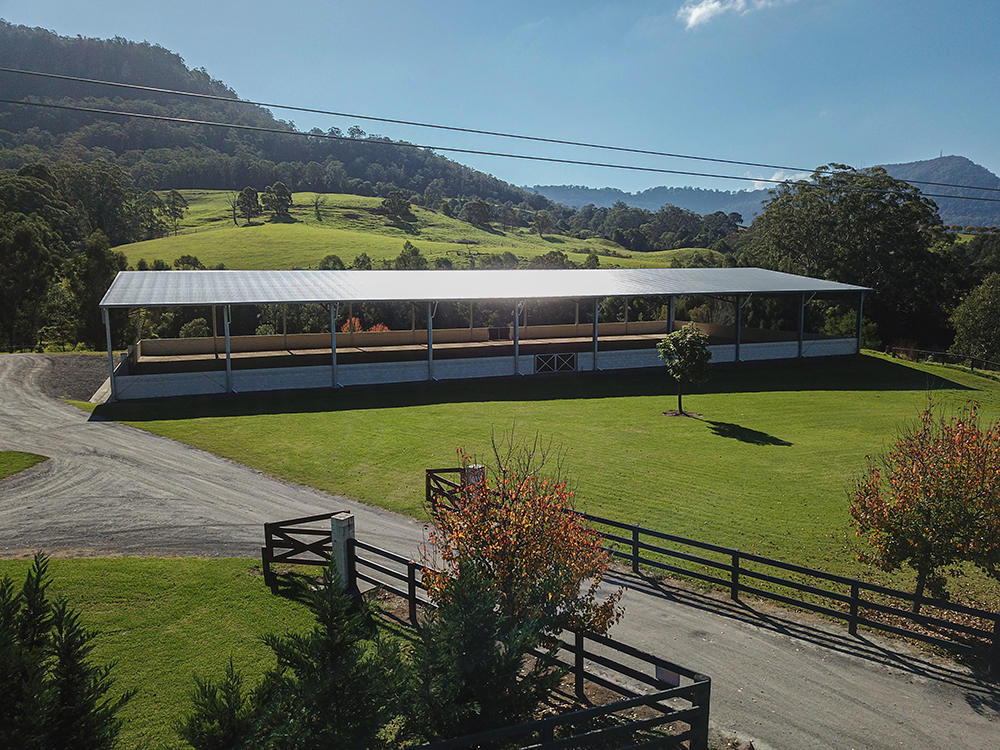
“It’s really important that there is ventilation.”
FEI dressage rider, coach and former judge, Roger Fitzhardinge, emphasises the importance of careful planning if you have aspirations of building a covered or indoor arena. He says the first thing to consider is position; take heed of prevailing winds and consider closing in certain sides, and ensure there is adequate drainage. Ventilation, particularly in Australia, is also crucial: “It’s really important that there is ventilation because in summer if you’ve got an indoor that’s fairly closed in, it gets stinking hot!” warns Roger.
With nearly three decades in the shed-building industry, the team at ABC Sheds have built numerous covered arenas for clients. Director Jonny Hornsey explains that while many clients choose to have some sides closed in to protect from prevailing weather, the vast majority of structures they’ve built have at least two open sides, ensuring they are well ventilated.
“With such vast extremes in our climate across Australia, we recommend clients spend a little bit of time thinking about the prevailing winds and how to maximise the breeze when needed,” says Jonny. “Spending the time in the planning stage can make a world of difference when using the arena!”
Soo Woods, of equine therapy provider Eureka Horse Wisdom, built a covered arena with ABC Sheds on her NSW Southern Highlands property. Initially designed as a shelter for her herd, it features two closed in sides for protection and two open sides for easy access and ventilation. Over time, the structure has become increasingly used as an arena, allowing her to run sessions with clients regardless of the weather.
Roger notes that additional details to consider include easy access, both for horse and rider (ideally a gate that can be easily opened on horseback) and also for a tractor and harrow. And then there are the kickboards, which Roger notes are a bit of a personal preference. “I don’t like to have kickboards that go straight up because you run your knee into it. You need them to come up from the ground to give the horses a line to ride, and then from about half a metre upwards they should be set at a sloping angle so your knee doesn’t hit the wall!”
There is another important aspect to consider when it comes to planning the position and structure of a covered or indoor arena, and that’s the vision. And no, that’s not that idealistic image you conjure up in your mind — it’s quite literally the vision you see from the back of your horse while riding!

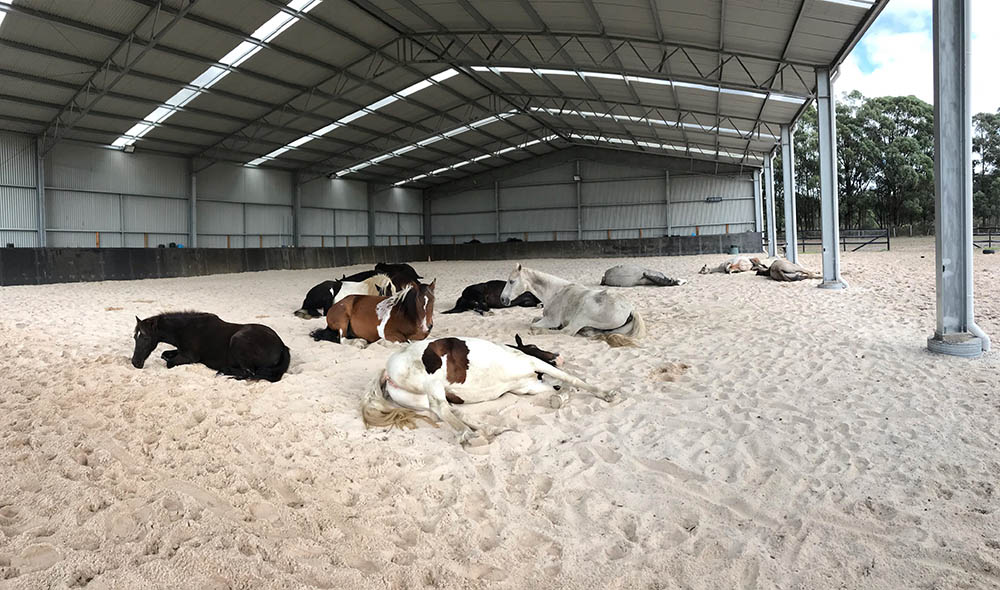
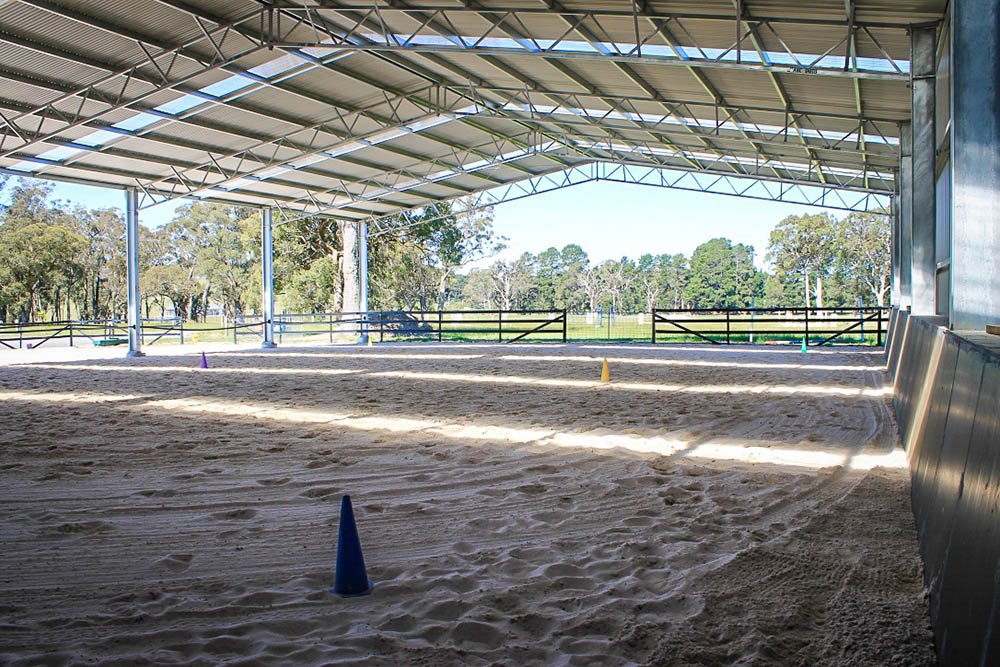
LET THERE BE LIGHT
Roger explains that the amount of lighting required really depends on how much natural light your arena will receive, and how much you plan to ride at night. “If you’re going to ride at night, you need to be really careful about shadows and that your eyes aren’t looking directly into the light source because that drives you crazy,” warns Roger.
And what about skylights? Much like the kickboards, Roger puts these down to personal preference. “I find skylights a bit distracting; when there’s bright sunshine, it can be like trotting over strobe lighting!”
If you are considering skylights, ABC Sheds’ virtual shed builder allows you to play around with the positioning to find a configuration that suits your personal needs.
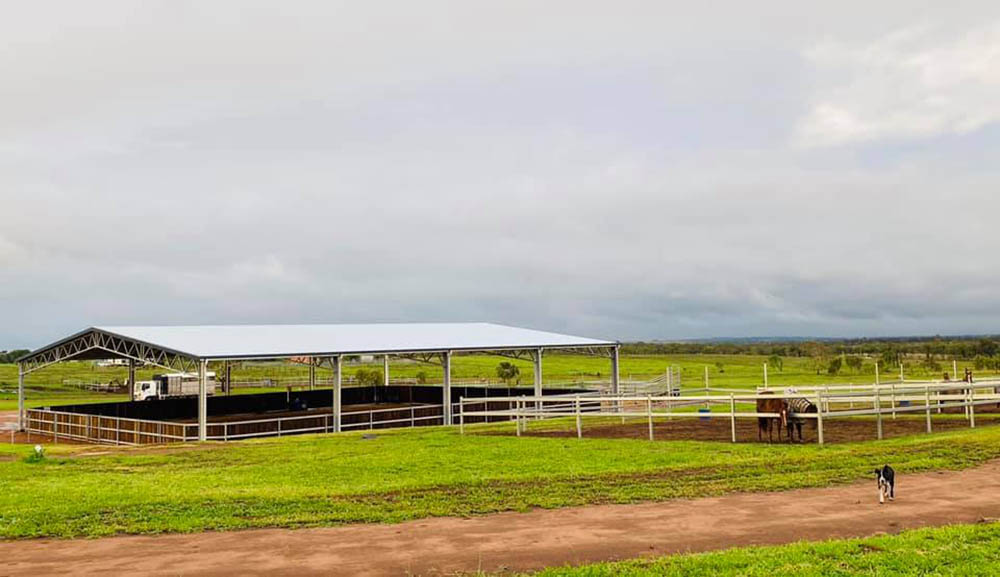
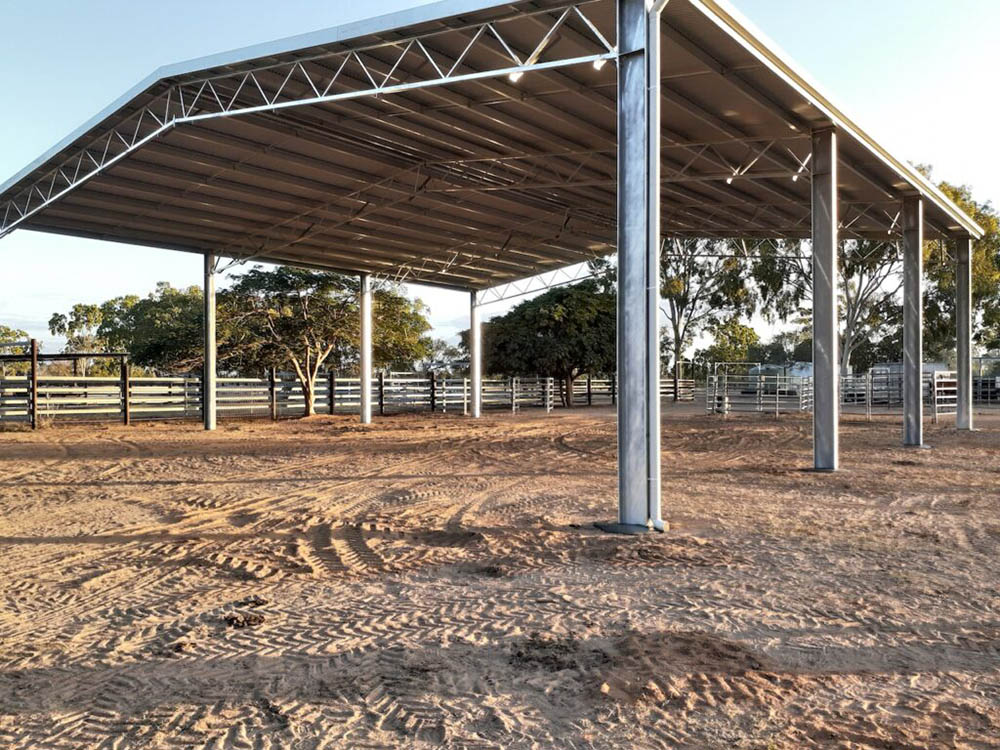
…BUT NOT TOO MUCH SUN!
Before you even think about laying the foundations for an arena, it’s important to think about sun direction. “In many parts of Australia, we’re more likely to use our covered arena to keep us shaded rather than keep the rain off us. So make certain that you’re getting maximum coverage in terms of shade,” says Roger.
Abe Graham, who trains cutting and campdrafting horses from his property near Rockhampton in Queensland, recently built a covered arena with ABC Sheds for the main purpose of providing shade. “I’ve got a little thermometer, and as a rule it’s about an eight-degree difference between outside and under the arena. On a 45 degree day, it’s the difference between working horses and not,” he says. Horsemanship expert David Stuart employed a similar wall-free design for his property in Nebo, and agrees that it really does make a difference if you’re training horses in Australia’s north: “It has got to be at least five or ten degrees cooler than out in the direct sun!”
Sun position varies a lot between winter and summer, so it’s important to be aware of this when positioning and designing an arena. The orientation of the arena cover, the use of walls or partial walls, and even side awnings can all work to reduce the sun’s impact in hot weather — and in cooler climates, through clever design it’s often possible to let in some sun during winter and then restrict it in summer.
VISIBILITY FOR YOUR EYES ON THE GROUND
If you’re building a covered arena on your property, then chances are you’re pretty serious about your horses and you’re likely to be having regular lessons. If that’s the case, it pays to think about where your coach will sit! As a coach himself, Roger has some words of advice: “If it’s a possibility to have a viewing area for coaches to sit, I like to either sit at C or on the long side, so incorporating a little area to be able to sit is also an important part of design.”
Fully customisable, ABC Sheds’ covered arenas can be designed to include a covered awning or skillion shed off the side of the main arena pitch, providing a covered area down the long side, and outside of the arena footprint. Depending on the size, it can be used for many things, from a simple walkway, to covered stabling — such as the ABC Sheds-designed arena at Robyne Smith’s Gwandalan Stables (see image) — and even storage. Of course, a seating area for your coach can easily be incorporated!

“Mirrors are of vital importance.”
SOMETHING TO REFLECT ON
In the era of Covid-19, most of us are spending more time at home training rather than heading off to competitions or riding at that state-of-the-art facility down the road. You’re also likely to have fewer eyes on the ground providing all-important feedback!
“For people interested in improving their riding and their horse’s posture, mirrors are of vital importance,” says Roger, noting that their positioning is important. “Mirrors right across the short sides are great, but if you have limited funds, you need at least one mirror on the short side so you can see yourself coming down the long side. This allows you to check straightness, the height of the horse’s poll, and the angles in shoulder-in and travers. And you can also see when you finish a movement like half-pass to the long side if you finish with a horse that’s correctly positioned for the new direction.” Roger also recommends having a mirror on the long side, either at E or B (or both). “The long side arena mirror allows you to see work on a 20-metre circle, the top line and the frame, and also you horse’s overtrack.”
In terms of how to use the mirrors in your training, Roger explains that they can help monitor everything from the position of your hands to the overall picture your horse presents. “You can look at things as you go past, like whether your hands are an equal height, whether your lower leg is in the right position, do you nod your head, are your elbows and forearms making straight lines from the bit through your wrists to your elbows? There are a multitude of rider position things that you can look at.”
As Roger explains, you only get limited time to glance at yourself in the mirror each time you pass, so it’s important to think specific in terms of what you are checking, for example, it might be your hands one time and your lower leg the next.
“You can also have an overall look at the picture; for example, is your horse’s frame how you want it? If you’re riding deeper and rounder, how deep and round is the horse, does it look light in the contact, or does it look like it’s leaning and on the forehead? You can check muscle development, you can check the use of the muscles, you can check regularity; are your horse’s strides the same? You can check the appearance of the canter… it feels good, but maybe it looks a little four-beat?

“Mirrors are a totally essential part of anyone’s flatwork training to see how your horse is going. Quite often, you feel that your horse is going fantastic and you look in the mirror and you realise, for example, that in terms of a competition frame you have your horse too deep, or too up and hollow and not using his hind end correctly.
“Mirrors are better than video because you actually get an immediate feedback and what you feel and what you see when you sync them together is really jelled into your mind in a positive way.”
Roger notes that if you plan to install mirrors, this needs to be considered in the initial design of the arena structure — and as discussed earlier, sun direction plays a part. “It’s important to consider where the sun comes from if you’re planning to build a covered arena with any partially or fully open walls, as you don’t want to be blinded by extremely bright sun reflection on the mirrors!”
If you’re keen to have mirrors integrated into your arena set-up, it pays to consider this during the planning phase. “Having a fully structural ABC Sheds arena cover means that you can attach the framing for mirrors, right where they are needed. All UB columns have the ability to have railing and framework attached at any time,” explains Jonny.
IT’S ALSO WHAT YOU CAN’T SEE
Considering visibility as part of your arena design also comes down to what you can’t see — or more specifically, what your horse can’t see!
Roger says that when designing an arena, it’s important to consider what’s nearby. “Positioning an arena near a noisy road or something scary… these things could perhaps worry horses. Having paddocks or yards directly outside a covered or indoor arena with a wall division means that ridden horses can’t see those outside horses galloping around the paddock — they can only hear them. This can cause issues for some.”
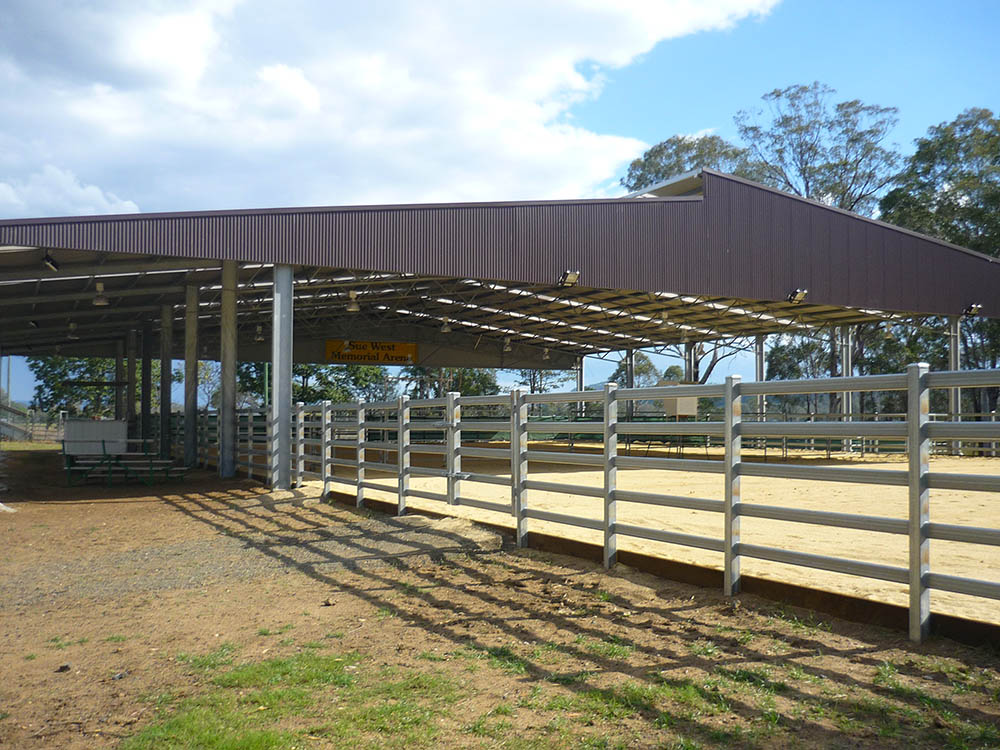
CUSTOMISATION IS THE KEY
At the end of the day, arena design really comes down to individual needs, preferences and, of course, budget. A covered or indoor arena is a big investment, and therefore taking the time to carefully consider all aspects — both big and small — is important. And once you’ve thought through the specifications for your dream arena, it’s then time to consider surfaces… and that’s a whole new article in itself that we won’t endeavour to cover here!
If you’re considering building a covered or indoor arena on your property and need more help deciding what specifications are right for you, the friendly team at ABC Sheds can assist. With nearly 30 years of experience in the shed building industry, they can help bring your dream arena to life. EQ
For more information regarding building a covered arena with ABC Sheds, visit www.abcsheds.net.au/dressage-arenas or download their free Equestrian Building Solutions brochure and start exploring the possibilities!

